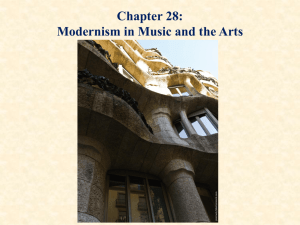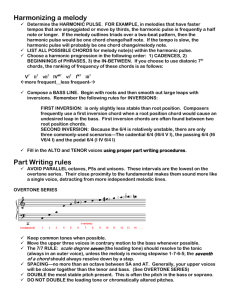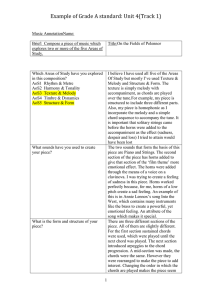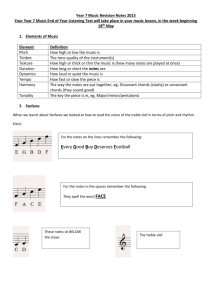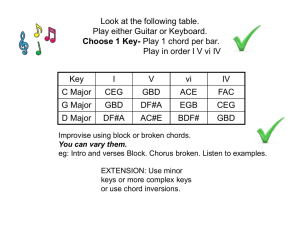QCC COURSE ASSESSMENT FORM QCC C A
advertisement
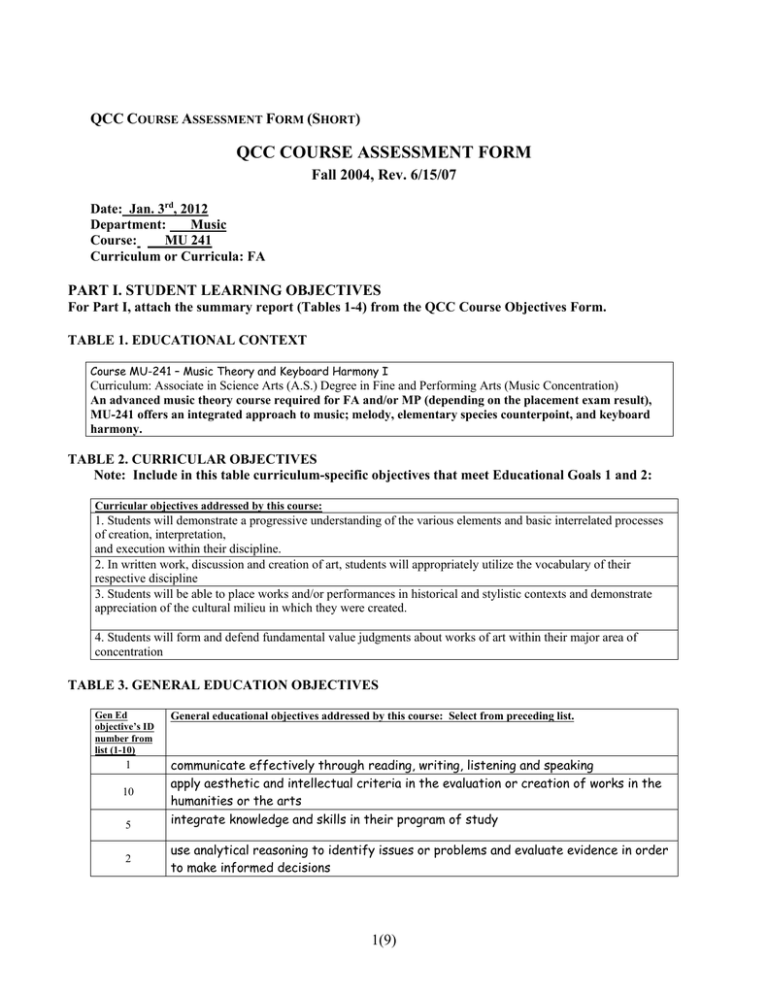
QCC COURSE ASSESSMENT FORM (SHORT) QCC COURSE ASSESSMENT FORM Fall 2004, Rev. 6/15/07 Date: Jan. 3rd, 2012 Department: Music Course: MU 241 Curriculum or Curricula: FA PART I. STUDENT LEARNING OBJECTIVES For Part I, attach the summary report (Tables 1-4) from the QCC Course Objectives Form. TABLE 1. EDUCATIONAL CONTEXT Course MU-241 – Music Theory and Keyboard Harmony I Curriculum: Associate in Science Arts (A.S.) Degree in Fine and Performing Arts (Music Concentration) An advanced music theory course required for FA and/or MP (depending on the placement exam result), MU-241 offers an integrated approach to music; melody, elementary species counterpoint, and keyboard harmony. TABLE 2. CURRICULAR OBJECTIVES Note: Include in this table curriculum-specific objectives that meet Educational Goals 1 and 2: Curricular objectives addressed by this course: 1. Students will demonstrate a progressive understanding of the various elements and basic interrelated processes of creation, interpretation, and execution within their discipline. 2. In written work, discussion and creation of art, students will appropriately utilize the vocabulary of their respective discipline 3. Students will be able to place works and/or performances in historical and stylistic contexts and demonstrate appreciation of the cultural milieu in which they were created. 4. Students will form and defend fundamental value judgments about works of art within their major area of concentration TABLE 3. GENERAL EDUCATION OBJECTIVES Gen Ed objective’s ID number from list (1-10) 1 10 5 2 General educational objectives addressed by this course: Select from preceding list. communicate effectively through reading, writing, listening and speaking apply aesthetic and intellectual criteria in the evaluation or creation of works in the humanities or the arts integrate knowledge and skills in their program of study use analytical reasoning to identify issues or problems and evaluate evidence in order to make informed decisions 1(9) TABLE 4: COURSE OBJECTIVES AND STUDENT LEARNING OUTCOMES Course objectives Learning outcomes 1. Students will use all chords and a. Students will use figured bass and roman numeral to label all the 7 chords from each major and minor key. b. Students will study musical examples from Bach, Mozart, Haydn and Beethoven to identify tonality and the 7 chords. a. Students will end each harmonization exercise with a cadence. b. Students will learn to identify the sound of each different cadence. scales from major and minor keys fluently 2. Students will learn to resolve a melody/tune with an appropriate cadence. 3. Students will learn to identify and create chords with figured bass and roman numerals. 4. Student will understand the rules of creating 4 part voice leading. a. Students will create and label all 7 chords in all keys. b. Students will study and compare the differences between figured bass and roman numerals. c. Students will create chords from both figured bass and roman numerals. a. Students will study rules from master works in listening and writing. b. Students will memorize, summarize and discuss the rules repeatedly through written exercises. a. Students will apply the rules to harmonize short 2 measure melody and progressively move to 4 to 8 measures for 4 part voice leading. b. Students will learn 4 part voice leading in well-designed steps: eginning with root position and slowly using first and 2nd inversions then to soprano harmonization. a. Students will study and memorize all the popular non chord tones in examples 6. Students will insert non chord and literature. tones to fill in gaps of melodies b. Students will apply the non chord tones in their composition and 4 part voice leading. 7. Students will resolve V7 chords in a. Students will listen, examine, analyze, memorize and V7 resolution rules from the the appropriate classical music style. music examples by Mozart, Haydn and Beethoven. b. Students will apply the rules in homework, project and exams to demonstrate the understanding of the resolution. 5. Students will create 4 part voices for a simple melody/tune 8. 9 10. a. b. a. b. a. b. 2(9) PART II. ASSIGNMENT DESIGN: ALIGNING OUTCOMES, ACTIVITIES, AND ASSESSMENT TOOLS For the assessment project, you will be designing one course assignment, which will address at least one general educational objective, one curricular objective (if applicable), and one or more of the course objectives. Please identify these in the following table: TABLE 5: OBJECTIVES ADDRESSED IN ASSESSMENT ASSIGNMENT Course Objective(s) selected for assessment: (select from Table 4) 1. Students will use all chords and scales from major and minor keys fluently 2. Students will learn to identify and create chords with figured bass and roman numerals. 3. Students will harmonize 4 part voices for a simple melody/tune Curricular Objective(s) selected for assessment: (select from Table 2) In written work, discussion and creation of art, students will appropriately utilize the vocabulary of their respective discipline General Education Objective(s) addressed in this assessment: (select from Table 3) Make informed judgments of the humanities and the arts as aesthetic and intellectual experiences Apply aesthetic and intellectual criteria in the evaluation or creation of works in the humanities or the arts In the first row of Table 6 that follows, describe the assignment that has been selected/designed for this project. In writing the description, keep in mind the course objective(s), curricular objective(s) and the general education objective(s) identified above, The assignment should be conceived as an instructional unit to be completed in one class session (such as a lab) or over several class sessions. Since any one assignment is actually a complex activity, it is likely to require that students demonstrate several types of knowledge and/or thinking processes. Also in Table 6, please a) identify the three to four most important student learning outcomes (1-4) you expect from this assignment b) describe the types of activities (a – d) students will be involved with for the assignment, and c) list the type(s) of assessment tool(s) (A-D) you plan to use to evaluate each of the student outcomes. (Classroom assessment tools may include paper and pencil tests, performance assessments, oral questions, portfolios, and other options.) Note: Copies of the actual assignments (written as they will be presented to the students) should be gathered in an Assessment Portfolio for this course. 3(9) TABLE 6: ASSIGNMENT, OUTCOMES, ACTIVITIES, AND ASSESSMENT TOOLS Briefly describe the assignment that will be assessed: Students will compose a melody of minimal 8 measures long or adopt an existing melody of similar length and harmonize it following the rules of music from Baroque and Classical periods they have learned from the course. Students will demonstrate use of all 7 chords from major or minor key with fluency. All the chords are to be labeled with cadences, roman numerals and non chord tones. The instructor will provide in class performance opportunity for each student to perform their own works. The students will listen and watch each performance. An election will follow for selecting the top 3 compositions to perform for the department student concert. Desired student learning outcomes for the assignment (Students will…) List in parentheses the Curricular Objective(s) and/or General Education Objective(s) (1-10) associated with these desired learning outcomes for the assignment. Briefly describe the range of activities student will engage in for this assignment. Course Objectives: a. Plan the length of the melody and decide the voice/instrument/ensemble b. compose or adopt a melody c. complete the harmonization in four party voice leading in Baroque and Classical period music style e. participate in-class performance with a short verbal presentation f. Hand in the final project in written format 1. 2. 3. Students will use all chords and scales from major and minor keys fluently Students will learn to identify and create chords with figured bass and roman numerals. Students will harmonize 4 part voices for a simple melody/tune Curricular Objectives: In written work, discussion and creation of art, students will appropriately utilize the vocabulary of their respective discipline General Objectives: Make informed judgments of the humanities and the arts as aesthetic and intellectual experiences Apply aesthetic and intellectual criteria in the evaluation or creation of works in the humanities or the arts 4(9) What assessment tools will be used to measure how well students have met each learning outcome? (Note: a single assessment tool may be used to measure multiple learning outcomes; some learning outcomes may be measured using multiple assessment tools.) Two assessment tools for this project: Written 4 part voice leading original or adopted melody in their own voice/instrument/ensemble no less than 8 measures in Baroque or/and Classical period music style In-class performance of the original composition PART III. ASSESSMENT STANDARDS (RUBRICS) Before the assignment is given, prepare a description of the standards by which students’ performance will be measured. This could be a checklist, a descriptive holistic scale, or another form. The rubric (or a version of it) may be given to the students with the assignment so they will know what the instructor’s expectations are for this assignment. Please note that while individual student performance is being measured, the assessment project is collecting performance data ONLY for the student groups as a whole. TABLE 7: ASSESSMENT STANDARDS (RUBRICS) Brief description of assignment: (Copy from Table 6 above) Students will compose a melody of minimal 8 measures long or adopt an existing melody of similar length and harmonize it following the rules of music from Baroque and Classical periods they have learned from the course. Students will demonstrate use of all 7 chords from major or minor key with fluency. All the chords are to be labeled with cadences, roman numerals and non chord tones. The instructor will provide in class performance opportunity for each student to perform their own works. The students will listen and watch each performance. An election will follow for selecting the top 3 compositions to perform for the department student concert. Desired student learning outcomes from the assignment: (Copy from Column 1, Table 6 above; include Curricular and /or General Education Objectives addressed) Course Objectives: 1. 2. 3. Students will use all chords and scales from major and minor keys fluently Students will learn to identify and create chords with figured bass and roman numerals. Students will harmonize 4 part voices for a simple melody/tune Assessment measures for each learning outcome: (Copy from Column 3,Table 6 above) Written 4 part voice leading original or adopted melody in their own voice/instrument/ensem ble no less than 8 measures in Baroque or/and Classical period music style In-class performance of the original composition Curricular Objectives: In written work, discussion and creation of art, students will appropriately utilize the vocabulary of their respective discipline General Objectives: Make informed judgments of the humanities and the arts as aesthetic and intellectual experiences 5(9) Standards for student performance: Describe the standards or rubrics for measuring student achievement of each outcome in the assignment. Give the percentage of the class that is expected to meet these outcomes If needed, attach copy(s) of rubrics. Critique from in class performance Grade of written project from the instructor Post experience: sharing, discussion and verbal feedback 80% of students may meet the expected outcome 100% perfection 90% Above average with minor mistakes 80% Satisfactory with minor mistakes 70% Satisfactory with some mistakes 60% Average with audible mistakes 50% Fail of the course Apply aesthetic and intellectual criteria in the evaluation or creation of works in the humanities or the arts 6(9) PART IV. ASSESSMENT RESULTS TABLE 8: SUMMARY OF ASSESSMENT RESULTS Use the following table to report the student results on the assessment. If you prefer, you may report outcomes using the rubric(s), or other graphical representation. Include a comparison of the outcomes you expected (from Table 7, Column 3) with the actual results. NOTE: A number of the pilot assessments did not include expected success rates so there is no comparison of expected and actual outcomes in some of the examples below. However, projecting outcomes is an important part of the assessment process; comparison between expected and actual outcomes helps set benchmarks for student performance. TABLE 8: SUMMARY OF ASSESSMENT RESULTS Desired student learning outcomes: (Copy from, Column 1,Table 6 above; include Curricular and/or General Education Objectives addressed) Course Objectives: 1. 2. 3. Students will use all chords and scales from major and minor keys fluently Students will learn to identify and create chords with figured bass and roman numerals. Students will harmonize 4 part voices for a simple melody/tune Curricular Objectives: In written work, discussion and creation of art, students will appropriately utilize the vocabulary of their respective discipline Student achievement: Describe the group achievement of each desired outcome and the knowledge and cognitive processes demonstrated. General Objectives: 1. Make informed judgments of the humanities and the arts as aesthetic and intellectual experiences 2. Apply aesthetic and intellectual criteria in the evaluation or creation of works in the humanities or the arts 75% students fulfilled the requirement of this project, 5% less than expected. Students used all chords from the key they composed. Students created chords and labeled them with roman numerals. Through participation in the composition of melody, harmonization, short presentation, and inclass performance, students communicated effectively in reading, writing, listening and speaking. The students had integrated their knowledge and skill of Baroque and Classical music in the composition and writing. Students had applied aesthetic and intellectual criteria in the creation of works while using analytical reasoning to identify problems and chose the best solutions (for best quality of sound). in order to make informed decision The execution of performance was also part of the evaluation in their artistic creation. 7(9) TABLE 9. EVALUATION AND RESULTING ACTION PLAN In the table below, or in a separate attachment, interpret and evaluate the assessment results, and describe the actions to be taken as a result of the assessment. In the evaluation of achievement, take into account student success in demonstrating the types of knowledge and the cognitive processes identified in the Course Objectives. A. Analysis and interpretation of assessment results: What does this show about what and how the students learned? The projected results of this planned assessment showed that 75% of the students created harmonized composition through the use of knowledge and skills of music from Baroque and Classical periods with varying degrees of success. Some students created Jazz style compositions as well as Gospel ones. Some students composed more difficult compositions than their performing skill thus the performance result did not reflect the level of their compositional writing. A few, 5%, failed the project while 20% of them were confused and struggled to complete partial work. The performance and presentation result varied. The assessment included in-class verbal comment, peer review, written work and grade for written work. The project of composition demonstrated students’ integration of theory and performance well. Students have gotten to know better at their own instruments/voices through writing for them. They also practiced their project to hear the sound of their own composition on their chosen voice/instrument. Overall, most students successfully applied procedural knowledge and were able to create their first composition in Baroque/Classical music style. B. Evaluation of the assessment process: What do the results suggest about how well the assignment and the assessment process worked both to help students learn and to show what they have learned? This project certainly aroused enthusiasm and inspiration in creating one’s own works with applied theory knowledge from this course and performance skill from the program. With motivation, some students created elaborated melodies that took them to the next level of ‘song writing’. Majority of them followed strict 4 par voice leading style with their melodies or melodies they picked. They labeled the chords, used a little non chord tones, inserted cadences at the ending, and practiced the composition for their instruments/voices. Some of them tried to integrate their own musical style, such as rock and jazz. Nonetheless, students understood the assignment and criteria for assessment well. Through listening, reading, singing, playing and writing, the project worked suitably to help students present, demonstrate and combine what they have learned from this course. They exemplified traditional and standard keyboard harmony and basic counterpoint well 8(9) in their project. C. Resulting action plan: Based on A and B, what changes, if any, do you anticipate making? Assessment may be broken into 4 stages for offering different guidance. 1. Selection/creation of melody 2. Chosen of instrument/voice/ensemble 3. Harmonization 4. performance Revision stages may be required for picking/writing the melody, submitting the partial work and then final product completion before the last performance. Steadfast check point may be established to avoid last minute crash work. The practice for project performance may be reinforced. A few of them were not ready for an in-class performance which was part of the grade. QCC 12/3/04 9(9) QCC COURSE OBJECTIVES FORM (SHORT) QCC COURSE OBJECTIVES FORM (Short) Fall 2004, rev. 6/15/07 Date: Jan. 3rd, 2012 Department: Music Course: MU 241 Curriculum or Curricula: FA TABLE 1: EDUCATIONAL CONTEXT OF THE COURSE Educational Context: Course MU-241 – Music Theory and Keyboard Harmony I Curriculum: Associate in Science Arts (A.S.) Degree in Fine and Performing Arts (Music Concentration) An advanced music theory course required for FA and/or MP (depending on the placement exam result), MU241 offers an integrated approach to music; melody, elementary species counterpoint, and keyboard harmony. TABLE 2: CURRICULAR OBJECTIVES Note: Include in this table curriculum-specific objectives that meet Educational Goals 1 and 2: Curricular objectives addressed by this course 1. Students will demonstrate a progressive understanding of the various elements and basic interrelated processes of creation, interpretation, and execution within their discipline. Briefly describe activities in this course which help students meet each of these curricular objectives 2. In written work, discussion and creation of art, students will appropriately utilize the vocabulary of their respective discipline 3. Students will be able to place works and/or performances in historical and stylistic contexts and demonstrate appreciation of the cultural milieu in which they were created. 4. Students will form and defend fundamental value judgments about works of art within their major area of concentration Students will review key signature, scales, circle of 5th, intervals, chords and inversions of chords from previous theory course. Students will learn to identify the sound of chords from I to vii as well as in writing. Students will write four part voice leading harmonization. Students will apply all the abovementioned in their instrumental performances and compositional writing. Students will listen, identify and select the most appropriate resolutions and cadences for ending each melody. Students will learn to label, read and create chords using figured bass and roman numerals. Students will demonstrate the use of V7 chord and the resolution for it. Students will learn non chord tones and demonstrate the use into the melody Students will demonstrate the ability to harmonize melody in 4 part voice leading. Students will apply contrapuntal and polyphonic texture in their assignment, homework, exercises and projects. Students will demonstrate their 4 part voice leading harmonization in Baroque and Classical period music style from their own homework and projects. Students will perform their own compositions of Baroque/Classical music in 4 part voice leading style on own instruments or ensemble. Students will discover and distinguish the compositional theory, writing techniques, sound and characteristics of Baroque and Classical period of music from others styles of music. Students will understand the theory of this course as the 1(4) foundation of classical music and establish esthetic value and views upon it. TABLE 3: GENERAL EDUCATION OBJECTIVES Gen ed objective’s identification number from preceding list (1-10) General educational objectives addressed by this course: Select from preceding list. Briefly describe activities in the course which help students meet each of these general education objectives communicate effectively through reading, writing, listening and speaking 1 10 apply aesthetic and intellectual criteria in the evaluation or creation of works in the humanities or the arts integrate knowledge and skills in their program of study 5 2 use analytical reasoning to identify issues or problems and evaluate evidence in order to make informed decisions 2(4) Students will answer questions using correct and new music theory vocabularies from this and previous course. Students will listen to chords in inversions, cadences, V7 resolutions and examples of non chord in the class and identify them. Students will read music examples from handout/textbook or on the board from the classroom exercises. Students will write concert report, musical assignment and compositional writing projects. Students will study and analyze listening and written examples from masters in the classical music history. Students will develop esthetic views, comprehend the style, tone colors and theory of Baroque and classical period of music. By utilizing their existing knowledge of music into classical music theory project, students improvise and compose their unique integrated sound of music and composition. Students will perform their own composition on the piano, in an ensemble or their own instrument. MP students will compose the music using synthetic sound or on the Sibelius program. Students will cultivate knowledge of 4 part voice leading. Students will assess, identify and evaluate the problems and make changes based on their learned knowledge. Students will listen and conduct open discussion of each other’s compositions which may provoke constructive comments and solution finding process. Note: Table 4 is prepared in two stages. Column 1 is prepared first. COLUMN 1 OF TABLE 4: COURSE OBJECTIVES:DESIRED STUDENT LEARNING 1.Students will use all chords and scales from major and minor keys fluently 2. Students will learn to resolve a melody/tune with a appropriate cadence. 3. Students will learn to identify and create chords with figured bass and roman numerals. 4. Student will understand the rules of creating 4 part voice leading. 5. Students will harmonize 4 part voices for a simple melody/tune 6. Students will insert non chord tones to fill in gaps of melodies 7. Students will resolve V7 chords in the appropriate classical music style. TABLE 4: COURSE OBJECTIVES AND STUDENT LEARNING OUTCOMES Course objectives (Note: copy objectives from the above Column 1 of Table 4 directly into this column.) 1. Students will use all chords and scales from major and minor keys fluently 2. Students will learn to resolve a melody/tune with an appropriate cadence. 3. Students will learn to identify and create chords with figured bass and roman numerals. 4. Student will understand the rules of creating 4 part voice leading. Learning outcomes a. Students will use figured bass and roman numeral to label all the 7 chords from each major and minor key. b. Students will study musical examples from Bach, Mozart, Haydn and Beethoven to identify tonality and all the 7 chords. a. Students will end each harmonization exercise with a cadence. b. Students will learn to identify the sound of each different cadence. a. Students will create and label all 7 chords in all keys. b. Students will study and compare the differences between figured bass and roman numerals. c. Students will create chords from both figured bass and roman numerals. a. Students will study rules from master works in listening and writing. b. Students will memorize, summarize and discuss the rules repeatedly through written exercises. a. Students will apply the rules to harmonize short 2 measure melody and progressively move to 4 to 8 measures in 4 part voice leading. b. Students will learn 4 part voice leading in well-designed steps: beginning with root position and slowly using first and 2nd inversions then to soprano harmonization. a. Students will study and memorize all the popular non chord tones in examples 6. Students will insert non chord and literature. tones to fill in gaps of melodies b. Students will apply the non chord tones in their composition and 4 part voice leading. 7. Students will resolve V7 chords in a. Students will listen, examine, analyze, memorize V7 resolution rules from the the appropriate classical music style. music examples by Mozart, Haydn and Beethoven. b. Students will apply the rules in homework, project and exams to demonstrate the understanding of the resolution. 5. Students will create 4 part voices for a simple melody/tune 8. 9 10. a. b. a. b. a. b. QCC 8/12/04 3(4) GLOSSARY OF TERMS Note: These definitions of terms are for the purposes of this assessment project only Entry-level course A credit course with no pre-requisites other than passing placement exams or required remediation; usually considered a first semester course; this course may be a pre-requisite for mid-level courses Mid-level course A course which has at least one credit course as a pre-requisite; usually a second or third semester course; this course may be a pre-requisite for upper-level courses Upper-level course A course, usually taken in the third or fourth semester, which has several credit course prerequisites (Student) Learning objectives An explicit statement of the skills and knowledge a student is expected to learn and be able to demonstrate either in general education, in a curriculum, or in a course (Student) Learning outcomes Student behaviors, performance, or activities that demonstrate that students are meeting or have met the learning objective(s) General education objectives Desired student learning in general education skills and in the liberal arts and sciences: communication, analytic reasoning and problem solving, quantitative skills and mathematical reasoning, information management, integration of knowledge, differentiation of values, development of personal and collaborative skills, history, social sciences, mathematics and sciences, the humanities and the arts Curricular objectives An explicit statement of the major points of learning that students must achieve to complete a program of study; these include both general education objectives and objectives specific to the curriculum Course objectives Major points of learning that students must achieve to complete a course; course objectives include general education objectives, curricular objectives, and objectives specific to the course 4(4)

